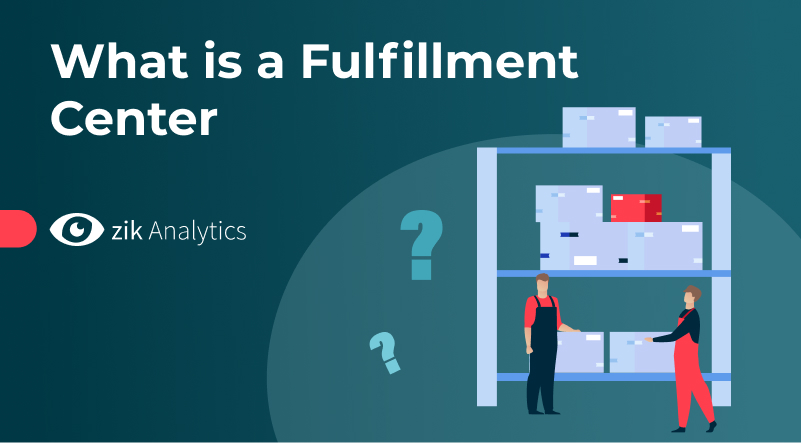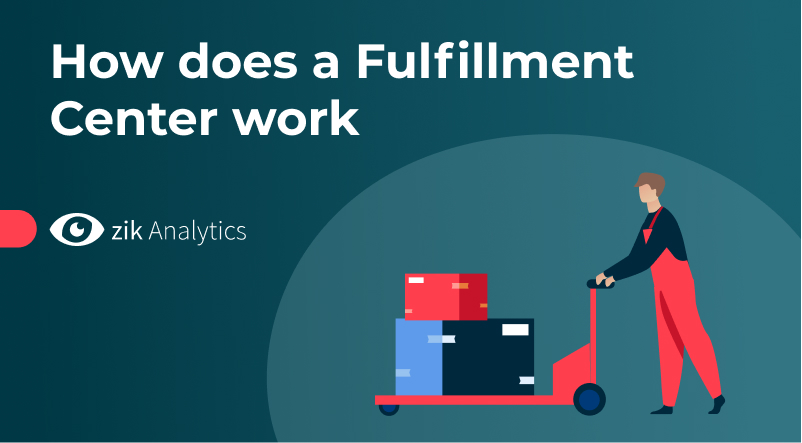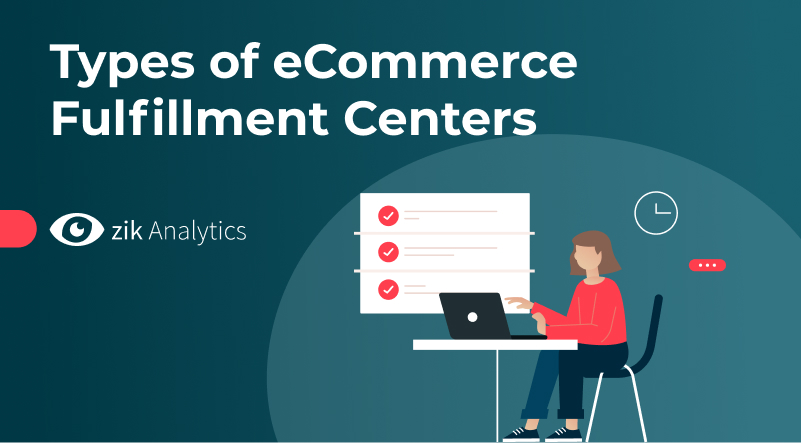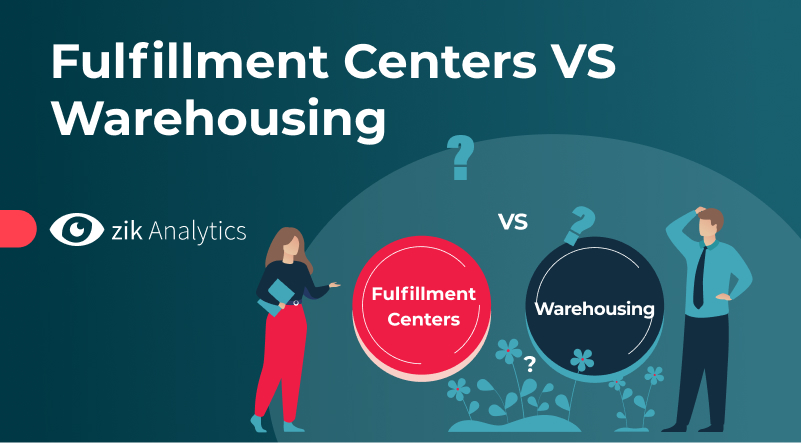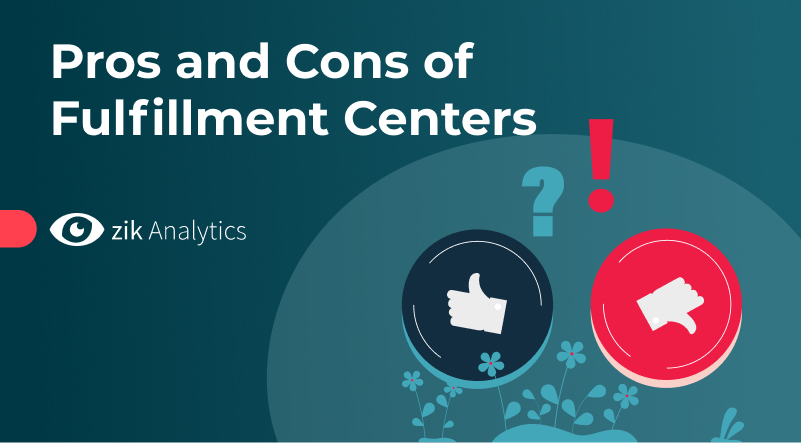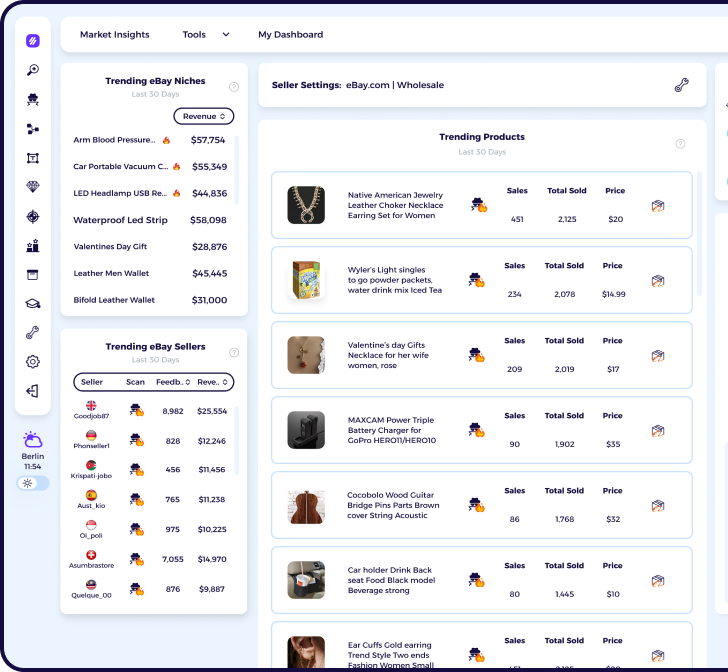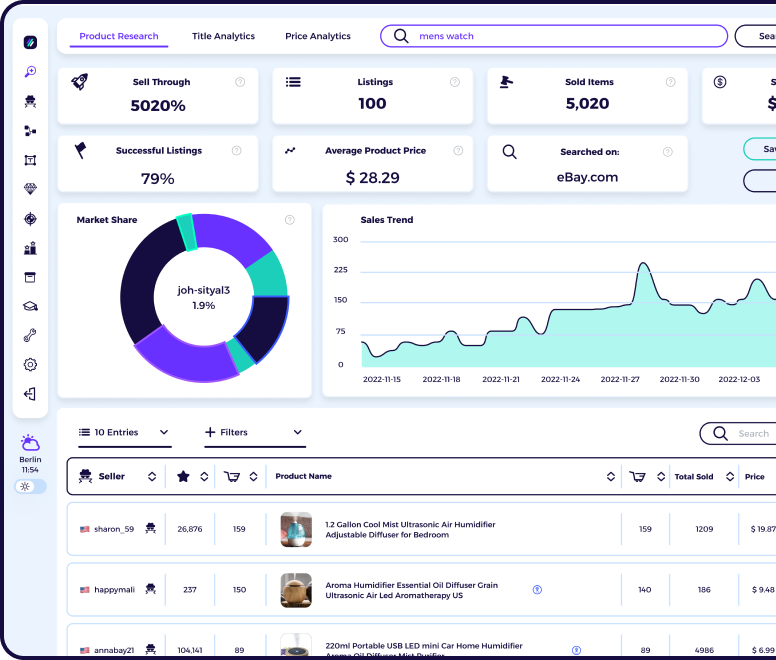You’ve probably heard the term fulfillment center. Maybe you’ve even used it yourself, without knowing exactly what it means.
You’re not alone—even many people in the retail e-commerce industry are confused about this! The term fulfillment center is often used interchangeably with warehouse, but they are not exactly the same thing.
A fulfillment center is a warehouse, but a warehouse isn’t necessarily a fulfillment center. Which begs the question, what is a fulfillment center?
A fulfillment center is like the nerve center of all the logistics processes for ecommerce retailers. It’s where you can store, pack, and ship your products, and it helps you manage the order fulfillment process.
For example, let’s say you sell socks online. You could have your inventory in a fulfillment center, where it would be stored until someone ordered a pair of socks from your site. When someone places an order for a pair of socks, it would be sent to the fulfillment center to be packaged up with other orders that are ready to go. The fulfillment center would then ship all of those packages out at once. Basically, they handle all logistics-related processes for you.
According to Insider Intelligence, in 2020, the global retail ecommerce market hit a sales value of $4 trillion, and this value is expected to hit $6 trillion in 2024. With this level of growth, it is expected that the technologies facilitating retail e-commerce operations will also advance.
How Does a Fulfillment Center Work?
Fulfillment centers are the unsung heroes of e-commerce. They pick, pack, and ship your products to customers’ homes so you can focus on running your business.
It can take more hours than there are hours in a day for a typical e-commerce business to pick, pack, and ship complete orders, as well as to manage accounting, sales, and other operational functions. This is where fulfillment centers come in.
The services fulfillment centers handle include:
- Real-time inventory management which involves tracking inventory levels in order to ensure they match customer demand.
- Picking, packing and kitting which involves packaging items together and shipping them together as a single item using the SKU.
- Transportation coordination which involves coordination of the entire process of shipping items from the warehouse to the end customer.
- Returns which involves transporting damaged or mis-shipped items back to the warehouse for processing and re-shipment.
- Storage involves safeguarding inventory for the e-commerce business until it can be used and shipped.
Types of eCommerce Fulfillment Centers
In-House eCommerce Order Fulfillment Services
In-house fulfillment is when the eCommerce business manages their order fulfillment process rather than outsourcing it to a third party. With in-house fulfillment, the retailer is expected to be responsible for picking, packing and shipping orders.
In-house fulfillment has its benefits and drawbacks. For example, it may be more expensive and more complex to fulfill orders in house than when using third-party logistics services that may employ advanced technology to manage orders easily.
Whether you should use in-house fulfillment or outsource it depends on a few key factors. If you have a low sales volume, then it should be both easier and less expensive to manage fulfillment in-house. For a startup, it might not make sense to invest in a fulfillment provider quite yet if you have not yet reached the point where order volume cannot be managed by one person.
For one thing, in-house fulfillment gives you complete control over your inventory levels, which is important for maintaining customer satisfaction and managing costs. Despite the flexibility that some 3PLs offer with regard to custom packaging and order customization, it can be difficult when you don’t have control over your inventory. Similarly, outsourcing isn’t a good idea if your brand is known for custom items and personalization that’s unique to each customer.
Dropshipping
Dropshipping is a perfect fulfillment strategy for anyone who wants to get started in e-commerce, but doesn’t want to spend a lot of money on inventory or deal with the hassle of shipping.
Here’s how it works: sellers purchase products from third-party suppliers such as wholesalers or manufacturers. Once they have these items in hand, they can ship them directly to the consumer. Basically. the seller is a middleman who doesn’t stock or own inventory.
Here are some facts that can provide insight into the global dropshipping market
- According to Statista, the global dropshipping market is expected to hit $196.78 billion in 2022.
- Dropshipping accounted for 23% of all global online sales in 2017 alone.
- There are about 15,901 Amazon dropshipping customer websites, as well as 4,296 WooCommerce 2.1 dropshipping customer websites.
Third-Party Logistics (3PL)
Third-party logistics is a fulfillment model that ecommerce businesses use when they outsource their supply chain management. Essentially, a 3PL is a company you outsource your entire supply chain operations.
The operations that the 3PL can help you carry out include transportation, inventory storage and management, freight forwarding, shipping/receiving and distribution, customs brokerage, cross-docking and picking and packing, and order fulfillment process.
According to Armstrong & Associates, about 90% of the Fortune 500 companies in the USA use a third-party logistics provider. It’s also been reported that in 2020, the global 3PL market was valued at $921.49 billion. These figures are indicative of the industry’s heavy reliance on third-party fulfillment services.
Fulfillment by Amazon
When you’re a little company with a lot of products, the logistics can be overwhelming. You’ve got to make sure your products are ready and waiting for customers, but how do you get them there?
With Fulfillment by Amazon (FBA), you don’t have to worry about that anymore. Amazon can handle all of your order fulfillment needs.
Fulfillment by Amazon is a fulfillment company that was started in 2006 as a part of Amazon’s efforts to help e-commerce retailers improve their sales and logistics process. In 2020, it was estimated that close to half of Amazon’s sales came from third-party sellers. Also, according to reports, 73% of Amazon sellers use FBA.
How does Amazon FBA work? Third-party sellers setup an Amazon selling account, and setup an inventory on Amazon. These businesses ship their products to Amazon fulfillment centers, and when a customer orders the product, Amazon picks, packs, and ships the item—making it easy for you to get your product from your warehouse floor to customers’ doorsteps with no hassle on your end. Customer service and returns processing are also available through Fulfillment by Amazon.
Differences between Fulfillment Centers and Warehousing
Every square is a rectangle, however, not every rectangle is a square. In the same vein, every fulfillment center is a warehouse, but not every warehouse is a fulfillment center. Let us compare and contrast the subtle differences between fulfillment centers and warehousing.
Storage
Storage usage is a major difference between warehouse space and fulfillment centers.
Warehouses are typically used to hold inventory for long-term, such as surplus inventory or products that are sold seasonally. However, fulfillment centers are used for storing inventory in short-term, basically with the purpose of consistently moving products in and out of the inventory. Because of the nature of storage in warehouses, they are less accessible than fulfillment centers.
Essentially, warehouses are designed for storage, while fulfillment centers are designed for shipping. Warehouses will often store inventory for future retrieval, whereas fulfillment centers are designed to efficiently meet customer satisfaction around shipping.
Ideally, a merchant should keep no more than one month’s worth of inventory in their fulfillment center. Otherwise, they risk paying high storage fees for the goods left there too long. Sellers should proactively ship more inventory to their fulfillment centers to ensure there is always enough product on hand before shipping.
Customers
An on-demand warehousing solution and a fulfillment company can also be distinguished by the type of customers they serve.
Warehouses serve B2B customers, while fulfillment centers are more tailored towards fulfilling orders for B2C and eCommerce businesses.
Mode of Operation
The mode of operation in a warehouse space is more static and less complex, unlike in a fulfillment center where operations are more complex and dynamic.
Inventory is usually shipped in and out of a warehouse on shipping pallet containers. Thus, logistics operations at warehouses often involve a freight carrier or even an intermodal provider. However, when inbound inventory shipments arrive at fulfillment centers, they arrive in pallets, and they ship out as parcel-sized shipments. This is a pointer to the level of complexity involved in both operations.
Another factor that dictates the level of complexity in the operation of a fulfillment center is the amount of time intended to store inventory for. Products in a fulfillment center are intended to be part of the inventory for a short period of time; while orders are meant to be fulfilled and shipped directly to the customers.
Frequency of Pickups
Fulfillment centers operate with a regular flow of inventory that begins once an order is placed, so shipping companies must provide a higher frequency of pickups to ensure on-time deliveries to customers. As a result, a fulfillment company can have relationships with many different shipping carriers who can be called upon as needed during specific periods of high demand.
A fulfillment center operates to fulfill direct-to-consumer orders as soon as they are placed and therefore requires shipping carriers to pick up shipments at least daily. This allows products to reach consumers on time.
However, warehouses don’t need as many pickup schedules since shipping freight and bundling boxes up on a pallet is more cost-effective than generating individual shipping labels.
Pros and Cons of Fulfillment Centers
Pros of the Fulfillment Centers
Eliminate Inventory Storage and Packing Materials From Your Business.
Many eCommerce startups, including Amazon, began with humble beginnings—working out of garages or basements. But as the business grew, so did the need for more space to store inventory and packing materials. In many instances, these “work spaces” become disorganized messes of bubble wrap, boxes and other packing supplies.
Managing a physical space as a small eCommerce company comes with dealing with the clutter that comes with it. It is usually not advisable for small e-commerce startups to open physical stores before they have established an online presence.
Using a fulfillment company can eliminate the need for inventory storage and packing materials, saving you money.
Improve Your Focus
As an entrepreneur or ecommerce retailer, you’re probably so focused on getting your company up and running, and you don’t have time to focus on all of the tasks that are required to make it successful. You need to be strategic about what you’re doing, which means focusing on the tasks that only you can do and those that will help you scale and make money.
By focusing less on fulfillment and more on marketing, customer service, and product management, e-commerce businesses can be more strategic. By working with a fulfillment center, you can focus your energies on these highlighted areas of the business and avoid having to worry about the fulfillment process.
Lower Shipping Costs
Third-party logistics companies can help companies save money in different areas, including shipping.
Typically, if your business has to operate from multiple warehouses and ship products from them, the higher your shipping costs will be. A fulfillment company may have warehouses all over the country and even overseas. By spreading your inventory across this network of warehouses, you can ensure that your buyers will receive their goods as quickly and efficiently as possible—and at a lower cost.
Reports indicate that distributing your inventory reduces shipping costs by 25% and lowers bottom-line costs by 13%.
Expertise of the Pros
When you’re a small business, it’s easy to get overwhelmed—especially if you’re trying to manage the fulfillment process on your own.
A single fulfillment center handles operations for many ecommerce businesses and ships millions of orders a year. Plus, the fulfillment company has extensive experience in order processing, inventory management, and peak season preparation. This wealth of experience makes a very excellent strategic partner for your business.
Cons of Fulfillment Centers
Lack of Control
Your fulfillment center can be a great partner, but it can also be a stressor. When you use a fulfillment center, you are relinquishing some control over your operations.
This is because when you use a fulfillment center, you are no longer able to see the order in front of you. Now, if you need to modify an order, it’s not as simple as grabbing a box cutter and walking over.
It may even be that the fulfillment center you’re using does not allow packages to be modified once they have been processed. If you will use fulfillment services, you must trust your 3PL (third-party logistics provider) to handle this big part of your business.
Loss of Personalization/Customization
If you outsource your business’ order processing and fulfillment, you’ll be forced to sacrifice putting a personal touch on your orders.
If you sell a particular product or service, your business might have unique processes in place that differ from those of other companies. It can be as simple as writing a greeting card to a strict quality control process that you put products through before final shipment. This means that any time an order is placed, there is no guarantee that it will be processed according to your company’s standards.
Even after finding a fulfillment center to meet your requirements, it can be difficult to maintain compliance with those standards.
Human Error
Despite the best technology, outsourcing still has the potential for human error. Human errors occur most often when communication breaks down between the fulfillment centers and e-commerce companies.
The company may get an unexpected number of returns on a particular product or not have enough supply of a popular item. This is especially problematic when inventory data isn’t up-to-date—confusion can arise and money can be lost.
Conclusion
In this post, we explored what fulfillment centers are, as well as the nuances that characterize fulfillment services.
Have you used a fulfillment center? Let us know in the comment section, how was the experience of using a fulfillment center?
